Omer Tov
Eye2Eye: A Simple Approach for Monocular-to-Stereo Video Synthesis
Apr 30, 2025Abstract:The rising popularity of immersive visual experiences has increased interest in stereoscopic 3D video generation. Despite significant advances in video synthesis, creating 3D videos remains challenging due to the relative scarcity of 3D video data. We propose a simple approach for transforming a text-to-video generator into a video-to-stereo generator. Given an input video, our framework automatically produces the video frames from a shifted viewpoint, enabling a compelling 3D effect. Prior and concurrent approaches for this task typically operate in multiple phases, first estimating video disparity or depth, then warping the video accordingly to produce a second view, and finally inpainting the disoccluded regions. This approach inherently fails when the scene involves specular surfaces or transparent objects. In such cases, single-layer disparity estimation is insufficient, resulting in artifacts and incorrect pixel shifts during warping. Our work bypasses these restrictions by directly synthesizing the new viewpoint, avoiding any intermediate steps. This is achieved by leveraging a pre-trained video model's priors on geometry, object materials, optics, and semantics, without relying on external geometry models or manually disentangling geometry from the synthesis process. We demonstrate the advantages of our approach in complex, real-world scenarios featuring diverse object materials and compositions. See videos on https://video-eye2eye.github.io
TokenVerse: Versatile Multi-concept Personalization in Token Modulation Space
Jan 21, 2025



Abstract:We present TokenVerse -- a method for multi-concept personalization, leveraging a pre-trained text-to-image diffusion model. Our framework can disentangle complex visual elements and attributes from as little as a single image, while enabling seamless plug-and-play generation of combinations of concepts extracted from multiple images. As opposed to existing works, TokenVerse can handle multiple images with multiple concepts each, and supports a wide-range of concepts, including objects, accessories, materials, pose, and lighting. Our work exploits a DiT-based text-to-image model, in which the input text affects the generation through both attention and modulation (shift and scale). We observe that the modulation space is semantic and enables localized control over complex concepts. Building on this insight, we devise an optimization-based framework that takes as input an image and a text description, and finds for each word a distinct direction in the modulation space. These directions can then be used to generate new images that combine the learned concepts in a desired configuration. We demonstrate the effectiveness of TokenVerse in challenging personalization settings, and showcase its advantages over existing methods. project's webpage in https://token-verse.github.io/
Still-Moving: Customized Video Generation without Customized Video Data
Jul 11, 2024

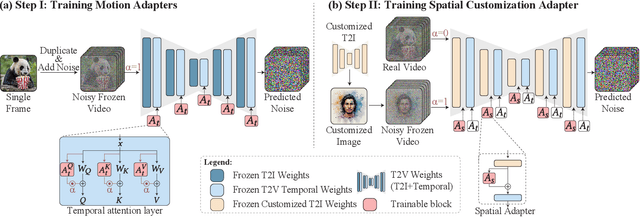

Abstract:Customizing text-to-image (T2I) models has seen tremendous progress recently, particularly in areas such as personalization, stylization, and conditional generation. However, expanding this progress to video generation is still in its infancy, primarily due to the lack of customized video data. In this work, we introduce Still-Moving, a novel generic framework for customizing a text-to-video (T2V) model, without requiring any customized video data. The framework applies to the prominent T2V design where the video model is built over a text-to-image (T2I) model (e.g., via inflation). We assume access to a customized version of the T2I model, trained only on still image data (e.g., using DreamBooth or StyleDrop). Naively plugging in the weights of the customized T2I model into the T2V model often leads to significant artifacts or insufficient adherence to the customization data. To overcome this issue, we train lightweight $\textit{Spatial Adapters}$ that adjust the features produced by the injected T2I layers. Importantly, our adapters are trained on $\textit{"frozen videos"}$ (i.e., repeated images), constructed from image samples generated by the customized T2I model. This training is facilitated by a novel $\textit{Motion Adapter}$ module, which allows us to train on such static videos while preserving the motion prior of the video model. At test time, we remove the Motion Adapter modules and leave in only the trained Spatial Adapters. This restores the motion prior of the T2V model while adhering to the spatial prior of the customized T2I model. We demonstrate the effectiveness of our approach on diverse tasks including personalized, stylized, and conditional generation. In all evaluated scenarios, our method seamlessly integrates the spatial prior of the customized T2I model with a motion prior supplied by the T2V model.
Lumiere: A Space-Time Diffusion Model for Video Generation
Feb 05, 2024



Abstract:We introduce Lumiere -- a text-to-video diffusion model designed for synthesizing videos that portray realistic, diverse and coherent motion -- a pivotal challenge in video synthesis. To this end, we introduce a Space-Time U-Net architecture that generates the entire temporal duration of the video at once, through a single pass in the model. This is in contrast to existing video models which synthesize distant keyframes followed by temporal super-resolution -- an approach that inherently makes global temporal consistency difficult to achieve. By deploying both spatial and (importantly) temporal down- and up-sampling and leveraging a pre-trained text-to-image diffusion model, our model learns to directly generate a full-frame-rate, low-resolution video by processing it in multiple space-time scales. We demonstrate state-of-the-art text-to-video generation results, and show that our design easily facilitates a wide range of content creation tasks and video editing applications, including image-to-video, video inpainting, and stylized generation.
Inflation with Diffusion: Efficient Temporal Adaptation for Text-to-Video Super-Resolution
Jan 18, 2024Abstract:We propose an efficient diffusion-based text-to-video super-resolution (SR) tuning approach that leverages the readily learned capacity of pixel level image diffusion model to capture spatial information for video generation. To accomplish this goal, we design an efficient architecture by inflating the weightings of the text-to-image SR model into our video generation framework. Additionally, we incorporate a temporal adapter to ensure temporal coherence across video frames. We investigate different tuning approaches based on our inflated architecture and report trade-offs between computational costs and super-resolution quality. Empirical evaluation, both quantitative and qualitative, on the Shutterstock video dataset, demonstrates that our approach is able to perform text-to-video SR generation with good visual quality and temporal consistency. To evaluate temporal coherence, we also present visualizations in video format in https://drive.google.com/drive/folders/1YVc-KMSJqOrEUdQWVaI-Yfu8Vsfu_1aO?usp=sharing .
Teaching CLIP to Count to Ten
Feb 23, 2023
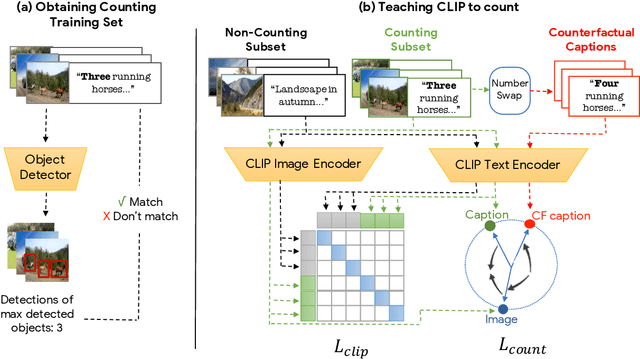
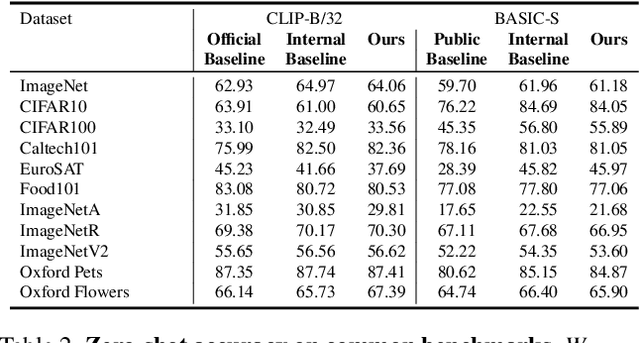
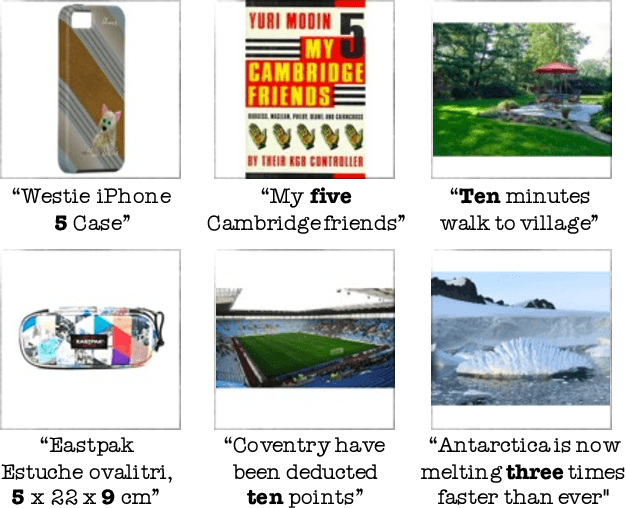
Abstract:Large vision-language models (VLMs), such as CLIP, learn rich joint image-text representations, facilitating advances in numerous downstream tasks, including zero-shot classification and text-to-image generation. Nevertheless, existing VLMs exhibit a prominent well-documented limitation - they fail to encapsulate compositional concepts such as counting. We introduce a simple yet effective method to improve the quantitative understanding of VLMs, while maintaining their overall performance on common benchmarks. Specifically, we propose a new counting-contrastive loss used to finetune a pre-trained VLM in tandem with its original objective. Our counting loss is deployed over automatically-created counterfactual examples, each consisting of an image and a caption containing an incorrect object count. For example, an image depicting three dogs is paired with the caption "Six dogs playing in the yard". Our loss encourages discrimination between the correct caption and its counterfactual variant which serves as a hard negative example. To the best of our knowledge, this work is the first to extend CLIP's capabilities to object counting. Furthermore, we introduce "CountBench" - a new image-text counting benchmark for evaluating a model's understanding of object counting. We demonstrate a significant improvement over state-of-the-art baseline models on this task. Finally, we leverage our count-aware CLIP model for image retrieval and text-conditioned image generation, demonstrating that our model can produce specific counts of objects more reliably than existing ones.
Imagic: Text-Based Real Image Editing with Diffusion Models
Oct 17, 2022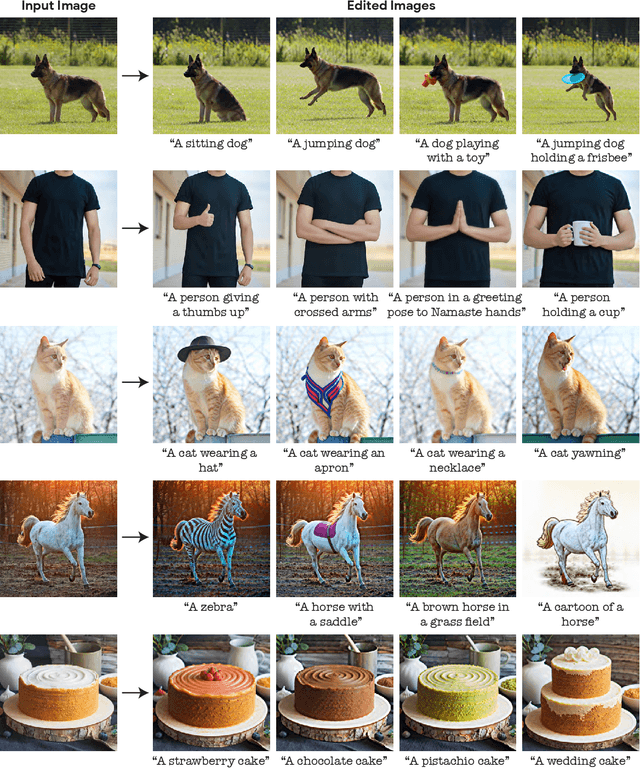

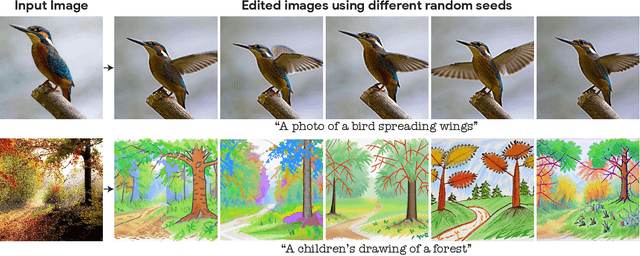

Abstract:Text-conditioned image editing has recently attracted considerable interest. However, most methods are currently either limited to specific editing types (e.g., object overlay, style transfer), or apply to synthetically generated images, or require multiple input images of a common object. In this paper we demonstrate, for the very first time, the ability to apply complex (e.g., non-rigid) text-guided semantic edits to a single real image. For example, we can change the posture and composition of one or multiple objects inside an image, while preserving its original characteristics. Our method can make a standing dog sit down or jump, cause a bird to spread its wings, etc. -- each within its single high-resolution natural image provided by the user. Contrary to previous work, our proposed method requires only a single input image and a target text (the desired edit). It operates on real images, and does not require any additional inputs (such as image masks or additional views of the object). Our method, which we call "Imagic", leverages a pre-trained text-to-image diffusion model for this task. It produces a text embedding that aligns with both the input image and the target text, while fine-tuning the diffusion model to capture the image-specific appearance. We demonstrate the quality and versatility of our method on numerous inputs from various domains, showcasing a plethora of high quality complex semantic image edits, all within a single unified framework.
State-of-the-Art in the Architecture, Methods and Applications of StyleGAN
Feb 28, 2022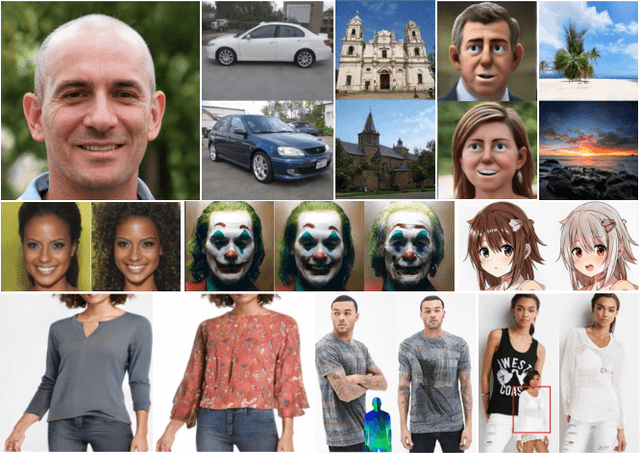
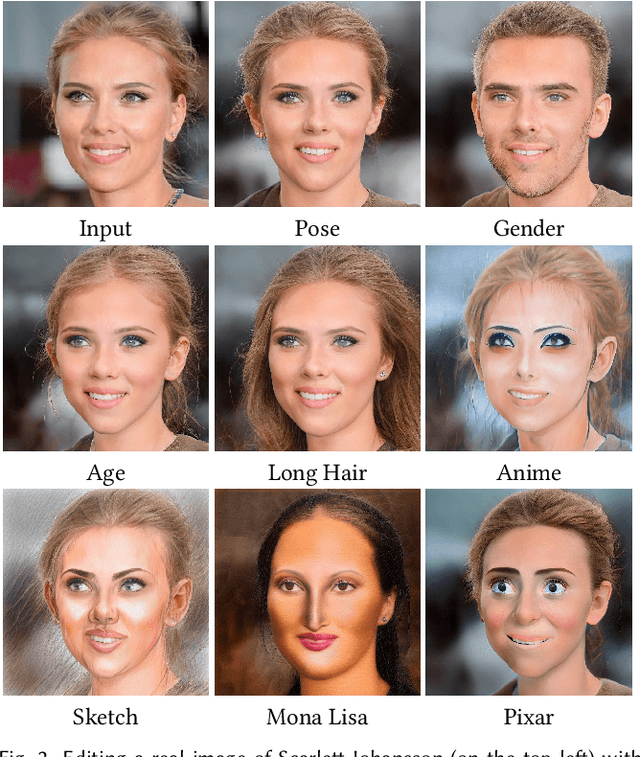
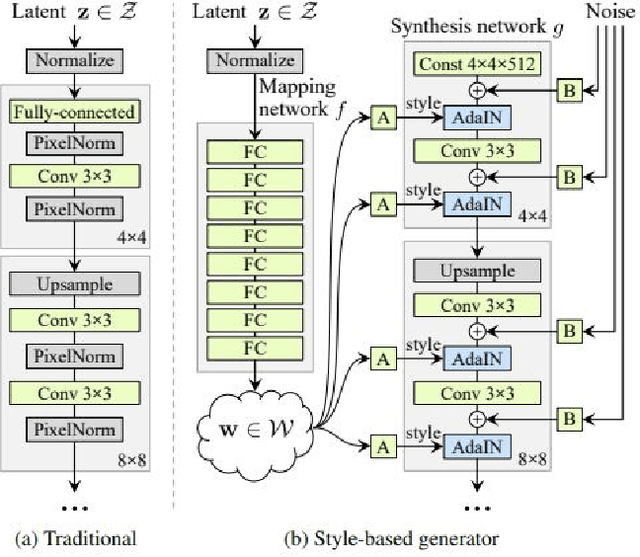
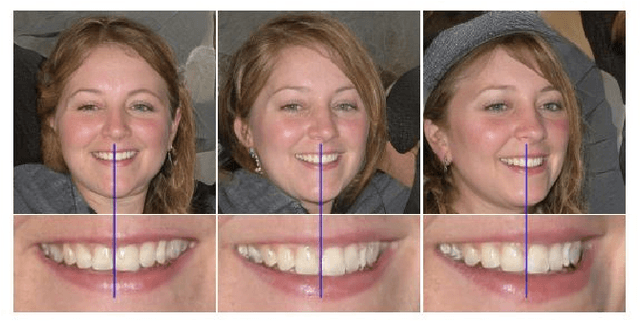
Abstract:Generative Adversarial Networks (GANs) have established themselves as a prevalent approach to image synthesis. Of these, StyleGAN offers a fascinating case study, owing to its remarkable visual quality and an ability to support a large array of downstream tasks. This state-of-the-art report covers the StyleGAN architecture, and the ways it has been employed since its conception, while also analyzing its severe limitations. It aims to be of use for both newcomers, who wish to get a grasp of the field, and for more experienced readers that might benefit from seeing current research trends and existing tools laid out. Among StyleGAN's most interesting aspects is its learned latent space. Despite being learned with no supervision, it is surprisingly well-behaved and remarkably disentangled. Combined with StyleGAN's visual quality, these properties gave rise to unparalleled editing capabilities. However, the control offered by StyleGAN is inherently limited to the generator's learned distribution, and can only be applied to images generated by StyleGAN itself. Seeking to bring StyleGAN's latent control to real-world scenarios, the study of GAN inversion and latent space embedding has quickly gained in popularity. Meanwhile, this same study has helped shed light on the inner workings and limitations of StyleGAN. We map out StyleGAN's impressive story through these investigations, and discuss the details that have made StyleGAN the go-to generator. We further elaborate on the visual priors StyleGAN constructs, and discuss their use in downstream discriminative tasks. Looking forward, we point out StyleGAN's limitations and speculate on current trends and promising directions for future research, such as task and target specific fine-tuning.
Self-Distilled StyleGAN: Towards Generation from Internet Photos
Feb 24, 2022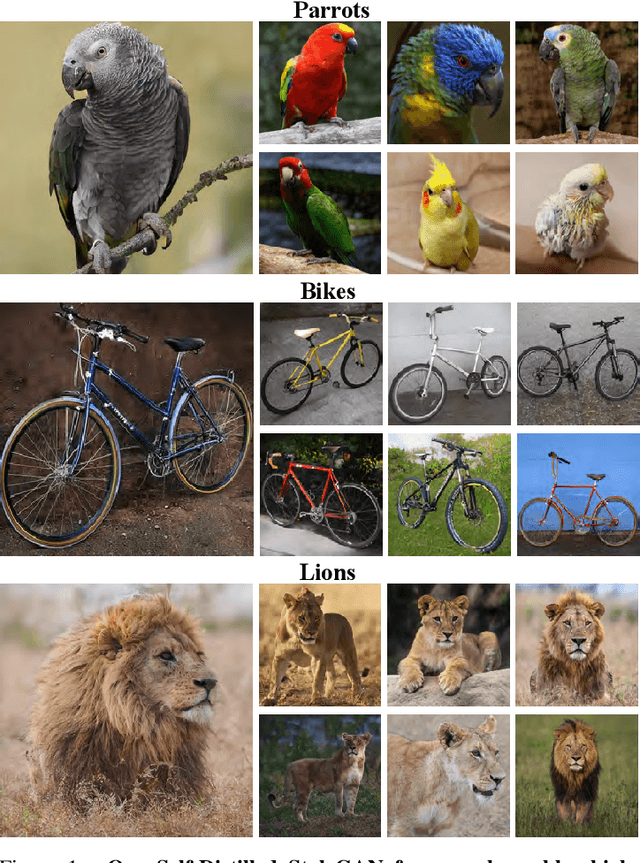
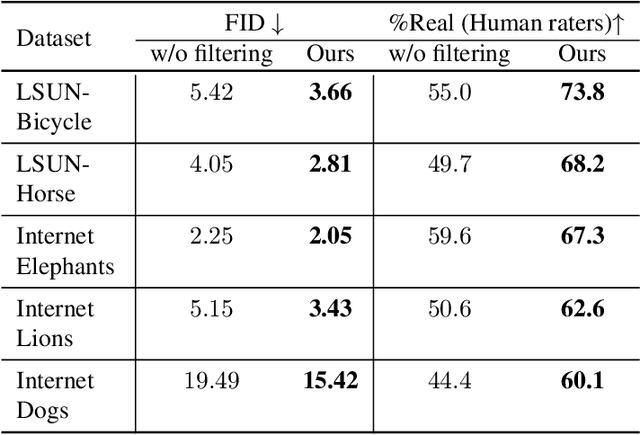

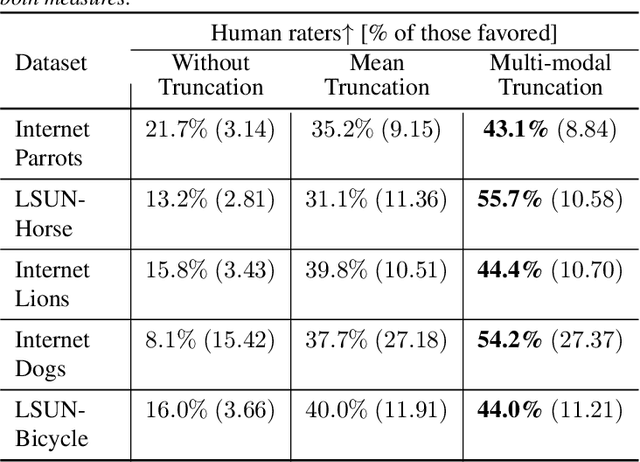
Abstract:StyleGAN is known to produce high-fidelity images, while also offering unprecedented semantic editing. However, these fascinating abilities have been demonstrated only on a limited set of datasets, which are usually structurally aligned and well curated. In this paper, we show how StyleGAN can be adapted to work on raw uncurated images collected from the Internet. Such image collections impose two main challenges to StyleGAN: they contain many outlier images, and are characterized by a multi-modal distribution. Training StyleGAN on such raw image collections results in degraded image synthesis quality. To meet these challenges, we proposed a StyleGAN-based self-distillation approach, which consists of two main components: (i) A generative-based self-filtering of the dataset to eliminate outlier images, in order to generate an adequate training set, and (ii) Perceptual clustering of the generated images to detect the inherent data modalities, which are then employed to improve StyleGAN's "truncation trick" in the image synthesis process. The presented technique enables the generation of high-quality images, while minimizing the loss in diversity of the data. Through qualitative and quantitative evaluation, we demonstrate the power of our approach to new challenging and diverse domains collected from the Internet. New datasets and pre-trained models are available at https://self-distilled-stylegan.github.io/ .
HyperStyle: StyleGAN Inversion with HyperNetworks for Real Image Editing
Nov 30, 2021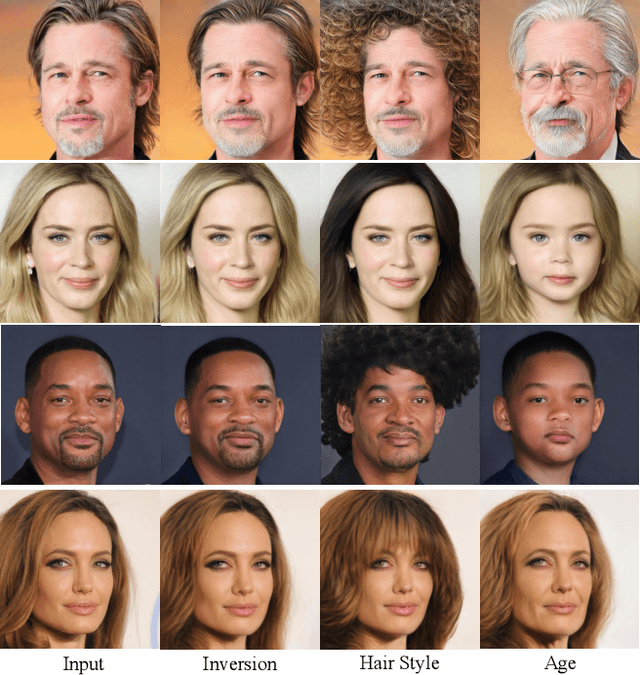
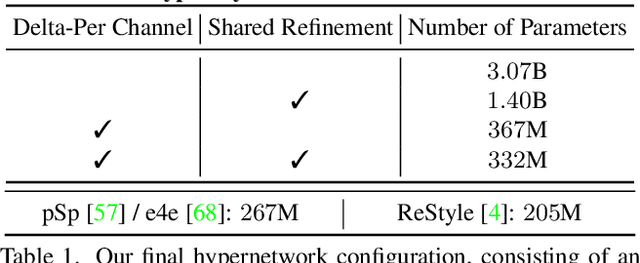

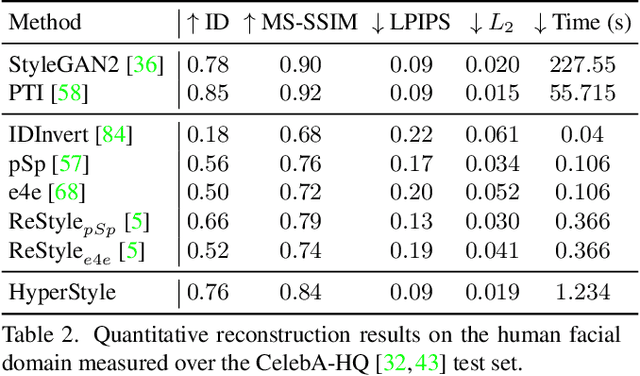
Abstract:The inversion of real images into StyleGAN's latent space is a well-studied problem. Nevertheless, applying existing approaches to real-world scenarios remains an open challenge, due to an inherent trade-off between reconstruction and editability: latent space regions which can accurately represent real images typically suffer from degraded semantic control. Recent work proposes to mitigate this trade-off by fine-tuning the generator to add the target image to well-behaved, editable regions of the latent space. While promising, this fine-tuning scheme is impractical for prevalent use as it requires a lengthy training phase for each new image. In this work, we introduce this approach into the realm of encoder-based inversion. We propose HyperStyle, a hypernetwork that learns to modulate StyleGAN's weights to faithfully express a given image in editable regions of the latent space. A naive modulation approach would require training a hypernetwork with over three billion parameters. Through careful network design, we reduce this to be in line with existing encoders. HyperStyle yields reconstructions comparable to those of optimization techniques with the near real-time inference capabilities of encoders. Lastly, we demonstrate HyperStyle's effectiveness on several applications beyond the inversion task, including the editing of out-of-domain images which were never seen during training.
 Add to Chrome
Add to Chrome Add to Firefox
Add to Firefox Add to Edge
Add to Edge